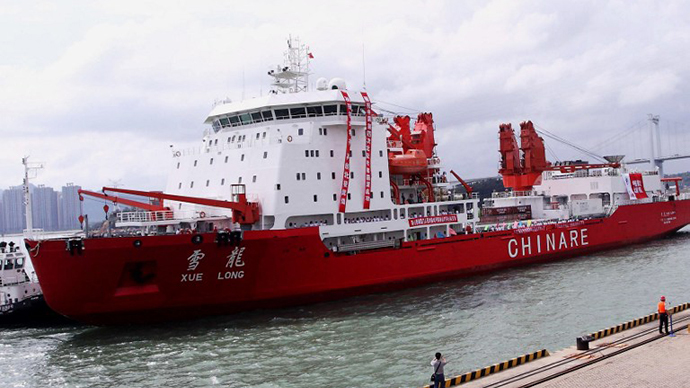China tests ‘most economical solution’ for shipping to Europe through Russian Arctic

The Chinese are the first to pilot a container-transporting vessel through the icy Northern Sea Route (NSR), a journey from China to Europe that decreases transport time by at least 12 days compared to the traditional Suez Canal route.
The 19,000-ton Yong Sheng, operated by Cosco Group, left the Chinese port of Dalian on August 8 and is set to dock in Rotterdam on September 11. The projected travel time, via the Bering Strait, is 12 to 15 days less than the southern route through the Suez Canal.
As Russia has been recently and significantly slowing its activity in the NSR, some experts say joining forces with China would help revive the route’s economics.
The volume of Russia’s shipments through the NSR has gone down five or six-fold since the 1980s to about a million tonnes of cargo in 2012. “In the meantime, operating a transport route from Arkhangelsk to Chukotka and further to Vladivostok is vital for Russia. That’s why I see a solution in cooperating with China and signing a special agreement on joint exploitation of the Northern Sea Route,” Andrey Ostrovsky, director of the Institute of the Far Eastern Studies, said to Russia’s Free Press.
On the other hand, risks weigh of China gaining some control over the Arctic. China is openly calling itself a subarctic state and is seeking to win icebreaking contracts from Russia. In addition, China has received the status of a ‘permanent observer’ in the Arctic council – the body regulating access to the Arctic’s huge energy resources. The Arctic’s oil reserves are estimated at 90 million tonnes, or 13 percent of the world’s supply, with natural gas reserves standing at 1.67 trillion cubic meters, or 30 percent of the world reserves, and liquefied natural gas weighing in at 44 billion barrels, or 20 percent of world stock.

“Economical solution”
Chinese state media have described the approximately 5440 km (3,400 mile) NSR as “the most economical solution" for shipping goods between Shanghai and northern European ports. If enough ice melts to create a viable shipping route, it would provide a politically safer route from the Egypt-controlled Suez Canal, and the pirate-populated Indian Ocean.
Travel distance between Shanghai and Hamburg would be shortened to 5200 kilometers, a shortcut that will save China both time and money.
As the ice melts, trade routes are rapidly commercializing in the Arctic. Last year, ice covered nearly 860,000 square miles, 53 percent less than the 1.8 million square miles of ice in 1917, according to US National Snow and Ice Data.
By 2021, about 15 million metric tons of cargo could be transported on the Arctic route, according to Llyod’s list, a shipping industry data firm. The cargo still pales in comparison to the 900 million tonnes of products and goods hauled through the Suez Canal in 2012.
In 2012, China became the world’s biggest trade nation’, with net trade of $3.87 trillion, beating out the US’s $3.82 trillion.













